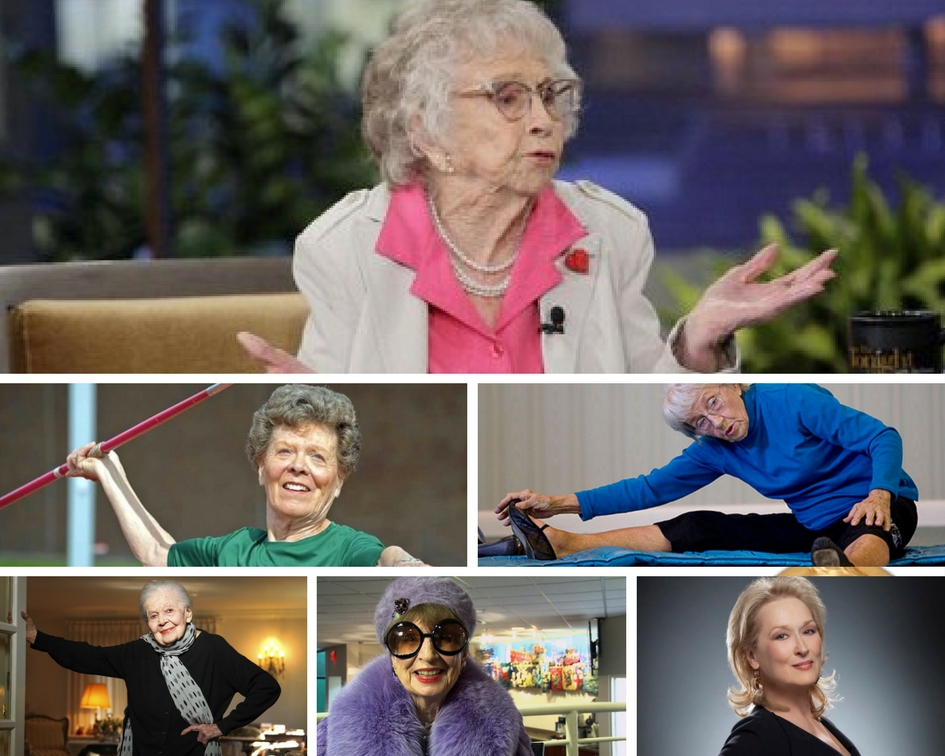WOMEN’S DAY: INSPIRATIONAL WOMEN OVER 60

From pioneering science and life-saving discoveries, to literary mastery and actions for peace and human rights, the role of women around the world has been of crucial importance. While International Women’s Day is a time to honor all women, it is noteworthy that many inspirational women come with wrinkles and grey hair. These signs of aging are hard won badges of honor. These women have spent decades in their respective fields, living through and creating incredible defining moments.
The 8th of March is an international day that celebrates the social, economic, scientific, cultural and political achievements of women. International Women’s Day also marks a call to action for accelerating gender equality and to celebrate ordinary women who have played a determinant role in the history of their countries and communities.
Check out these links to interesting Women’s Day topics below:
Meaning and History of International Women’s Day
The importance of celebrating Women’s Day
Did you know? UNESCO and UN facts
Women’s Rights Movement Timeline
Inspirational Quotes by Senior Women
Meaning and History of International Women’s Day
According to UNESCO, the first event that triggered what would be the first International Women’s Day was on February 28, 1908, when a group of 15,000 women marched on the streets of New York, protesting for their rights. But it wasn’t until 1945 that the Charter of the United Nations established the first international agreement to state the principle of equality between women and men. The UN celebrated its first official International Women’s Day 42 years ago, on March 8, 1975.
After that, countries across the world have come together on March 8 to celebrate the social, economic, cultural, scientific and political achievements of women.
The main goal of this day is to focus on the role of women in innovation, education and the workplace, in order to foster a more inclusive and egalitarian world. Women all over the world will be recognized for their commitments to their countries and communities and for the inequities they still face in 2017.
In the U.S., women have had the right to vote for less than 100 years. Nowadays, the right to vote is something we take for granted, but it took a great deal of struggle from the women’s suffrage movement to achieve this most basic right. In the 1970s, there was a second wave of protests for equal rights with women fighting for control of their health, sexuality, career and personal life.
The 2017 theme for International Women’s Day is: “Planet 50-50 by 2030: Step It Up for Gender Equality.”
The importance of Celebrating Women’s Day
International Women’s Day is a time to reflect on the achievements made, to celebrate acts of courage and determination by both renowned and ordinary women, who have played extraordinary roles in moving the world forward.
We all want to live in a society where women and girls can exercise their choices, free from violence and discrimination. Therefore, it is important to share experiences, spreading the word on good practices that will raise awareness and promote gender policies and strategies that advocate for the end of violence against women.
Did you Know? UNESCO and UN FACTS
The world is changing and many of these changes have significant implications for women. Despite these new opportunities, we still have a long way to go to meet the goal “Planet 50-50 by 3030”, considering that:
- 31 million girls of primary school age are not in school (UNESCO, 2013);
- 35% of women worldwide have experienced either physical and/or sexual violence in their lives (UN, 2015);
- Nearly 2/3 of illiterate people are women, a proportion that has remained unchanged for two decades (UN, 2015);
- Less than 4% of CEOs in the world’s largest 500 corporations are women (UN, 2015);
- Women account for 2/3 of the world’s poorest citizens (UNESCO, 2014);
- Women are underrepresented in scientific and technological disciplines. Only 29% of the world’s researchers are women (UNESCO, 2014).
If you want to explore more UN facts on where women stand today in the changing world of work, click here.
Nobel Prize Awarded Women
The Nobel Prize has been awarded to women 49 times between 1901 and 2016. Marie Curie has been honored twice, with the 1903 Nobel Prize in Physics and the 1911 Nobel Prize in Chemistry.
Of the 11 American women awarded the Nobel Prize, most were at least 50 at the time they won:
From the upper-left corner:

- 1931, Jane Addams (71) – The Nobel Peace Prize
- 1938, Pearl Buck (46) – The Nobel Prize in Literature
- 1946, Emily Greene Balch (79) – The Nobel Peace Prize
- 1977, Rosalyn Yalow (56) – The Nobel Prize in Physiology or Medicine
- 1983, Barbara McClintock (81) – The Nobel Prize in Physiology or Medicine
- 1988, Gertrude B. Elion (70) – The Nobel Prize in Physiology or Medicine
- 1993, Toni Morrison (62) – The Nobel Prize in Literature
- 1997, Jody Williams (47) – The Nobel Peace Prize
- 2004, Linda B. Buck (57) – The Nobel Prize in Physiology or Medicine
- 2009, Carol W. Greider (48) – The Nobel Prize in Physiology or Medicine
- 2009, Elinor Ostrom (76) – The Prize in Economic Sciences
To learn more about these and worldwide female Laureates, check: “Nobel Prize Awarded Women”.
Women’s Rights Movement Timeline
According to Melanne Verveer (The Daily Beast), director of the Institute for Women, Peace and Security at Georgetown University and the first U.S. Ambassador for Women’s Global Issues: “Women’s progress in any place is progress for our world”.
What contributions have American women made towards global progress on gender equality? Here is a timeline, adapted from Infoplease Encyclopedia, that covers the key events of the women’s rights movement in the U.S.:
- 1848 – The first women’s rights convention in Seneca Falls, New York. A set of 12 resolutions is adopted for equal treatment of women and men under the law and voting rights for women
- 1893 – Colorado is the first state to adopt an amendment granting women the right to vote. Utah and Idaho follow in 1896, Washington State in 1910, California in 1911, Oregon, Kansas, and Arizona in 1912, Alaska and Illinois in 1913, Montana and Nevada in 1914, New York in 1917; Michigan, South Dakota, and Oklahoma in 1918
- 1896 – The National Association of Colored Women is formed, bringing together more than 100 black women’s clubs
- 1916 – Margaret Sanger opens the first U.S. birth-control clinic in Brooklyn, New York
- 1936 – The federal law prohibiting the dissemination of contraceptive information through the mail is altered and birth control information is no longer classified as obscene
- 1960 – The Food and Drug Administration approves birth control pills
- 1961 – President John Kennedy establishes the President’s Commission on the Status of Women and appoints Eleanor Roosevelt as chairwoman
- 1969 – California becomes the first state to adopt a “no fault” divorce law, which allows couples to divorce by mutual consent
- 1978 – The Pregnancy Discrimination Act bans employment discrimination against pregnant women
- 1984 – EMILY’s List (Early Money Is Like Yeast) is established as a financial network for pro-choice Democratic women running for national political office
- 1994 – The Violence Against Women Act tightens federal penalties for sex offenders, funds services for victims of rape and domestic violence, and provides for special training of police officers
- 2016 – Women will be allowed to serve in any job in the armed services, provided they meet gender neutral performance standards
Inspirational women over 60
In addition to the celebrities who inspire us, there are plenty of fascinating women over 60 who deserve our attention and admiration.
The accomplishments of famous or ordinary women, regardless of age, continuously inspire women around the world. These are examples of American women over 60 that keep inspiring the whole world:
From the upper-left corner:

- Iris Apfel, 95, a legendary designer of jewelry and clothing
- Carmen Dell’Orefice, 85, the world’s oldest supermodel
- Ernestine Shepherd, 81, the world’s oldest female bodybuilder
- Betty White, 95, actress with the longest television career of a female entertainer
- Christie Brinkley, 63, had the longest running cosmetics contract of any model in history
- Ruth Bader Ginsburg, 84, the second female justice in United States history, nominated in 1993 at the age of 60
- Alice Waters, 73, the first woman to win the James Beard Foundation’s Best Chef in America award
- Annie Leibovitz, 67, photographer of the most iconic pictures of celebrities, including the famous photograph of John Lennon and Yoko Ono in a bed
- Susan Sarandon, 70, Academy Award winning, also known for her social and political activism.
Inspirational quotes by Senior Women
If asked to name the inspirational women in our lives, most of us would understandably name our mother, grandmother, sister, or a close friend. It would not be difficult to recall the advice and important stories they’ve shared with us. With that in mind, here are some inspirational quotes by women that have been through it all:

- Dorothy Custer, 102, American comedian and the oldest person to leap off a bridge 500 feet above the Snake River:
“I never thought of age. I just went on living and having a good time.”
- Flo Meiler, 79, formerly a Senior Olympic tennis player:
“I keep telling (seniors) that it’s never too late. If I can take up track and field at 60, anybody can take up another sport at age 50 and up.”
- Bernice Bates, 92, Guinness World Record for the ‘Oldest Yoga Teacher’:
“We’re the only living thing on Earth that has the body that we do — that can think, can do, can cry, can talk. We should take care of it.”
- Marta Eggerth, 101, Opera and movie Star:
“People ask me ‘How is it to be 100?’ I say, ‘I don’t know. I have no standard of comparison. You must ask me when I am 200 what it was like to be 100, and then I will be able to tell you’.”
- Harriet Lake, 91, philanthropist, donated more than 3,000 items from her closet for a 15-day sale to raise money for Orlando Health’s level 1 trauma center:
“A basic black dress which you can buy at COSTCO for 18 bucks will take you anywhere.”
- Meryl Streep, 67, actress and philanthropist:
“You have to embrace getting older. Life is precious, and when you’ve lost a lot of people, you realize that each day is a gift.”
Since its inception, International Women’s Day has grown into a worldwide celebration of past and present accomplishments of women, and will continue to foster opportunities for future generations of women.
Women have proven they can bring new qualities to leadership that can help our world move forward in a way that is more cooperative and less confrontational. Both women and men benefit from living in a society built on fairness and equality.

 USA
USA